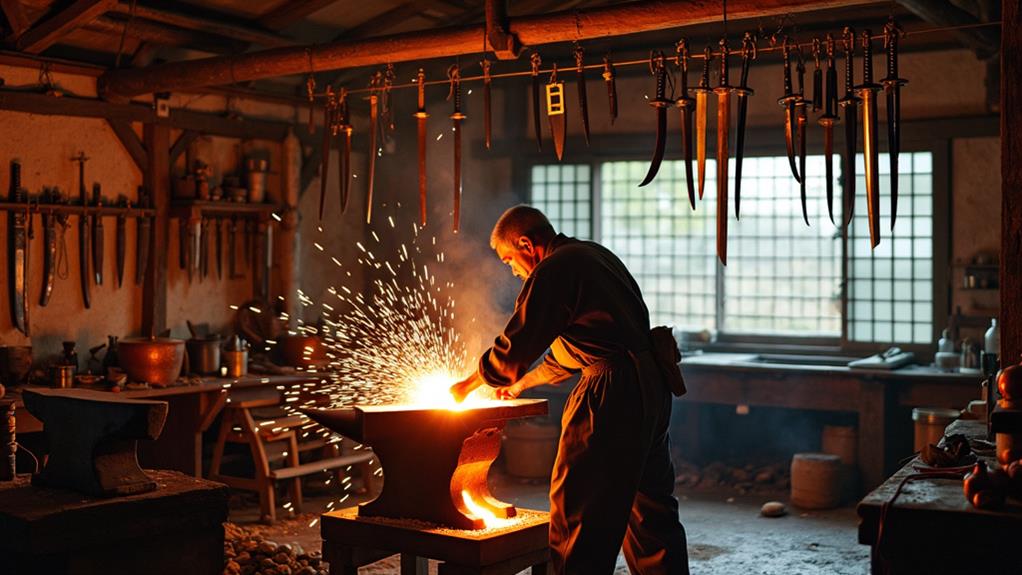
The katana forging process takes raw tamahagane steel and turns it into a flawless blade. First, swordsmiths carefully select and purify the steel, removing impurities to enhance durability. They then use intricate folding techniques, which create layers and a unique surface pattern. Heating and quenching the blade hardens it, and through precise shaping and polishing, the edge becomes sharp and refined. Each stage combines tradition and skill, resulting in a beautiful and functional work of art. If you want to uncover more about the techniques and history behind this remarkable craft, there's plenty more to explore.
Key Takeaways
- The katana begins with the careful selection and preparation of high-quality tamahagane steel from iron sand.
- The forging process involves intricate folding and layering techniques to enhance strength, flexibility, and eliminate impurities.
- Heat treatment and tempering are performed to achieve the desired hardness and durability in the blade.
- The blade is meticulously shaped and polished to enhance its geometry and reveal the unique features of tamahagane steel.
- The final product is a masterpiece, reflecting both artistic beauty and the rich traditions of Japanese swordsmithing.
Characteristics of Japanese Swords
Japanese swords are truly remarkable for their unique blend of strength and elegance. You'll find that their design isn't just about looks; it reflects a rich history dating back to the Kamakura period, when samurai warriors sought blades that represented their elite status. These swords stand out due to their exquisite craftsmanship, which emphasizes both beauty and utility.
The katana's key parts, such as the blade and handle, play crucial roles in enhancing its functionality and aesthetic appeal. The characteristic tamahagane steel, crafted from iron sand and charcoal, is key to their exceptional quality. This low-impurity steel offers superior durability, allowing the sword to perform extraordinarily in battle.

As you admire the blade's flowing curves and sharp edges, remember that it's the result of a precise forging process, using piston-operated bellows to regulate the heat. The blade's features, including the nagasa, sori, and kissaki, contribute to its performance and elegance, showcasing a traditional warrior's artistry that has been passed down through generations.
The combination of a softer, flexible core encased in harder steel creates a sword that's not only strong but also capable of delivering razor-sharp cuts. Every angle and detail matters, as they connect you to the spirit of the samurai. Whether you're a collector or simply an admirer, appreciating these characteristics can deepen your sense of belonging to a tradition that values both artistry and strength.
Dual Composition of Katana
One of the defining features of a katana is its dual composition, which combines two types of steel to create a blade that excels in both strength and sharpness. This unique construction reflects the artistry of Japanese swordmaking, ensuring each katana is not just a weapon, but a piece of history.
In this dual-layered design, the core steel, known as shingane, is softer and flexible. It provides the katana with resilience. Meanwhile, the hard outer layer, called kawagane, delivers a razor-sharp cutting edge. The careful combination of these steels, primarily tamahagane, allows for a blade that can withstand the rigors of combat while maintaining its sharpness.
| Steel Type | Characteristics |
|---|---|
| Shingane | Softer, flexible, resilient |
| Kawagane | Harder, maintains cutting edge |
| Tamahagane | Low-impurity Japanese steel |
The precise layering and folding during the forging process is critical to achieving the katana's renowned strength and versatility. When you hold a katana, you're not just holding a blade; you're holding a tradition—one that speaks to the heart of Forging Japanese culture.
Tools and Forge in Swordsmithing
Crafting a katana requires a specialized set of tools and precision-forged techniques that have been passed down through generations. To ensure the longevity of your finished blade, it's crucial to understand proper maintenance techniques such as key maintenance practices.
As you step into the world of swordsmithing, you'll find that each tool plays a vital role in transforming raw materials into a breathtaking blade. A piston-operated bellows is essential for controlling the intense heat in your forge, where high-purity pine charcoal fuels the fire. This smoke from the charcoal brings a unique character to the forging process.

You'll rely on specialized hammers and tongs, crafted for the purpose of shaping and grasping the hot steel block. These tools help guarantee the precision needed for every curve and edge.
During the smelting of tamahagane steel, the fire lighting ritual adds a ceremonial touch, connecting you to traditions of the past. Every moment spent monitoring the tamahagane not only ensures the removal of impurities but also fosters a sense of community in the craft, helping you develop a shared identity with fellow swordsmiths.
Combining these various materials and techniques, you'll unlock the secrets to creating a katana that echoes generations of craftsmanship.
Purification and Layering Process
The purification and layering process is indispensable for crafting a quality katana. As you immerse yourself in this step, you'll see how traditional Japanese techniques guarantee the steel becomes strong and flexible.
First, you'll want to start with tamahagane, a high-quality steel created from iron sand. This steel isn't just any material; it's the heart of your katana, as it has been used for centuries, showcasing its importance in the forging techniques and materials behind samurai swords.
Once you have your tamahagane, it's time for purification. This involves heating the steel carefully and removing impurities, making sure only the best elements remain. In this way, the steel becomes more durable and ready to be shaped into a blade.
Next comes the layering process. You'll take your purified steel and stack it, folding it several times. This careful layering not only increases strength but also enhances the flexibility of the blade, giving it unique performance qualities.
As you work through this process, remember that each layer tells a part of your story. Carrying on these traditional methods connects you to the rich history of Japanese swordsmithing, fostering a sense of belonging within this time-honored craft.
The Folding Technique
Harnessing the art of folding, swordsmiths create a blade that embodies both beauty and function. You'll find this technique crucial in transforming raw material into a work of art. By repeatedly cutting and folding the steel block, they gradually reduce carbon content and impurities, resulting in thousands of thin, enmeshed steel layers. This meticulous process not only strengthens the blade but also creates a distinctive surface pattern known as jihada.

Swordsmiths alternate the folding direction between cross-wise and length-wise, which helps achieve a uniform steel structure. They use water quenching during this process to increase the hardness of the steel, ensuring durability. Plus, rice straw ashes play a fundamental role in preventing carbon loss while layering the tamahagane steel.
This folding technique is a cornerstone of traditional Japanese sword-making. It's what gives the katana its signature strength, flexibility, and incredibly sharp cutting edge. By participating in this time-honored craft, you connect deeply with a tradition that thrives on skill, patience, and respect for the materials that shape your blade into its final shape.
Final Blade Shaping and Polishing
You'll find that the final blade shaping and polishing of a katana is a pivotal phase that elevates the sword from mere steel to a masterpiece. Master swordsmiths dedicate themselves to this intricate process, carefully grinding, sanding, and polishing to create a razor-sharp edge of the blade. They use specialized tools like whetstones and polishing stones, taking care to refine the blade's geometry and enhance its unique hamon, or temper line pattern.
This stage isn't just about function; it's also an art form. The meticulous polishing can take hours, revealing the katana's beautiful grain patterns and the excellence of the tamahagane steel. As you watch, you can appreciate how each stroke and moment spent polishing brings out the katana's character, leaving it not only striking in appearance but also balanced in weight.
It's a process that transforms the blade into something truly special, showcasing the swordsmith's years of skill and the katana's impressive cutting performance. When complete, you see a work of art that reflects a rich tradition, inviting you to connect with its beauty and history.
Cultural Significance of Katana
Cultural significance surrounds the katana, transcending its role as a mere weapon. This iconic sword is a profound symbol of Japanese heritage, reflecting deep values and traditions. When you hold a katana, you're not just gripping a sword handle; you're connecting to a history rich with meaning.
The katana embodies the virtues of the samurai, reminding you of their commitment to honor and self-discipline.

For samurai, the katana was more than a tool for battle; it was an essential part of their soul, representing their spiritual path and bushido code.
The katana's unique design, with its carefully crafted curved blade, showcases the Japanese dedication to detail and beauty, making every sword a treasured piece of art.
Owning a katana is about becoming part of a long-standing tradition. Passed down through families, these swords symbolize strength, history, and a deep sense of belonging to a culture that values craftsmanship and honor.
Frequently Asked Questions
What Is the Process of Forging a Katana?
When you forge a katana, you'll use folding techniques to layer the steel, then follow precise quenching procedures to achieve the perfect balance between strength and flexibility, creating a blade that resonates with tradition and skill.
How Is a Katana Blade Made?
To make a katana blade, you'd use steel tempering techniques and precise blade shaping methods. This intricate process results in a weapon that embodies tradition, strength, and beauty, connecting you to a rich cultural heritage.
How Many Times Do You Fold Steel for a Katana?
When you're forging a katana, you typically fold the steel around 10 to 18 times. Those steel folding patterns create strength and beauty, connecting you to the rich tradition of Japanese sword-making techniques.
How Were Samurai Swords Forged?
You'd marvel at how samurai swords were forged, blending ancient folding techniques with traditional forge methods. Each strike and fold creates a strong yet beautiful blade, connecting you to centuries of craftsmanship and the warrior's legacy.
Conclusion
In summary, the katana isn't just a weapon; it's a work of art forged through skill and tradition. By understanding the unique materials and techniques involved, you appreciate the beauty and strength of each blade. From the careful layering to the meticulous polishing, every step has purpose. So next time you see a katana, remember the rich history and craftsmanship behind it. It truly represents the spirit of Japanese culture and the dedication of its swordsmiths. For those interested in owning a piece of this tradition, Musashi Swords offers a range of authentic and replica katanas that embody this centuries-old craftsmanship.


